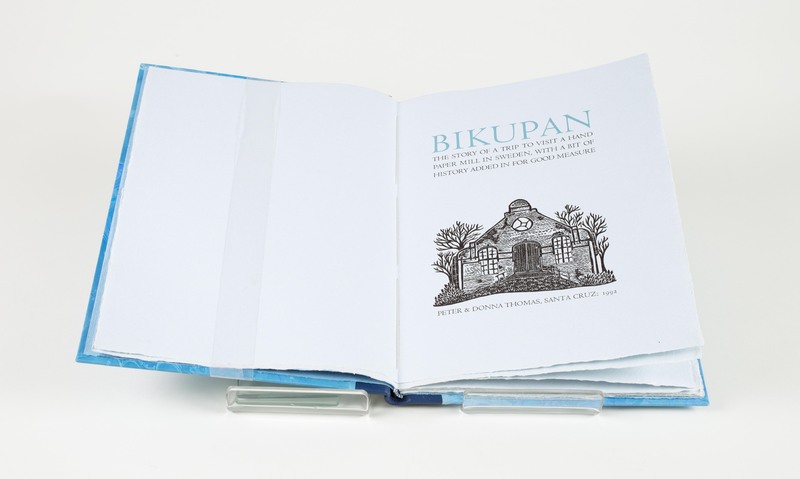A69. Bikupan
A69. Peter Thomas. Bikupan. Santa Cruz, California: Peter & Donna Thomas, 1992.
26.5 x 19 cm (10 ½” x 7 ½”), 31 pages, 119 copies.
Binding: Quarter-bound in leather and blue marbled paper. Title in gold on spine. End sheets dark blue. Some copies housed in a slipcase covered in blue book cloth and blue paper handmade by Peter Thomas. Paper: Blue, handmade by Peter Thomas in 1983 using white and black rags and blue pigment. Printing: Letterpress; some illustrations printed from metal engravings. Typography: Monotype Centaur and Arrighi; title and half title in blue. Illustration: Opening initial, one linocut, and reproductions of twelve line drawings of watermarks by Donna Thomas. Six samples of paper made at the Lessebo Paper Mill tipped in.
“The text combines research by Henk Vroon about the history of papermaking in Sweden, an essay by Bo Rudin about the history of the Lessebo mill, and my journal entries documenting my visit to the mill. The Lessebo mill in Sweden was at the time one of the few remaining traditional handmade paper mills in the world. It was open to visitors during the summer months, and offered daily guided tours. We arrived after the end of the season. They still allowed visitors, but there were no tours. The day I visited, there were two men working at the vat making a medium size sheet of paper. I asked them questions, but they did not speak English. I spent an hour taking slides and made the video recording of them at the vat, then went upstairs to the gift shop. I asked if there was any old paper for sale. They took me up into the loft of the mill. There I was shown a shelf full of old paper. Most of it was packed in reams made up of sets of five sheets folded in half. It was a thrill to be able to feel that wonderful old gelatin sized paper, to pull it out of its ream wrappers and see the work of skilled craftsmen from the past. Most sheets were not watermarked. Two were dated 1907 and 1908, not old when compared to the mill itself, but old enough for me. I was told that in the 1950s the mill had sold off much of its old paper, and since this paper was dated it was not available for sale. There were several smaller sheets with watermarks and no dates for sale, so I bought them to include in this book. The first of the sample papers tipped in was made in 1990 and the rest were made some time in the mid-twentieth century, although exactly when is unknown. When I got back to the gift shop the mill manager was there and, excited by my interest, he took me back into the break room to meet the papermakers. In perfect English, they greeted me and asked why I was so interested in watching them make paper. Go figure.
The book is titled Bikupan, which means bee hive, both as a reference to the shape of the buildings (which is depicted in the illustration across from the title page), and to the bee hive watermark in the newer sheet of paper we bought to include as a sample. Working with this theme, rather than printing a traditional half-title, we printed a quote taken from Tycho Brahe’s gravestone (and found again later in the text) ‘let us work while we have time…’ a reference to the bee hive and a recognition of how much work it takes to make paper and make fine press books.
At the time we were striving to figure out how to make our fine press books more of an artwork than a beautiful literary work. One way we thought to achieve that goal was to make sure each page spread was visually interesting. So rather than having pages and pages of uninterrupted text, as in a classic fine press book, we alternated a page spread of text with a page spread featuring a paper sample. On the text sheet before and after the paper samples we printed the watermarks from the sample sheets, right reading on the verso and wrong reading on the recto. We think of this as our first fine press artists’ book.”
